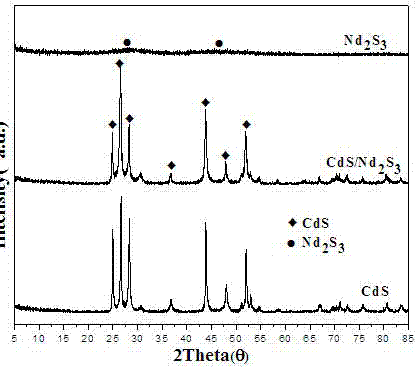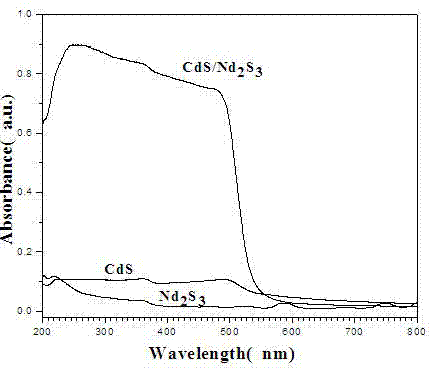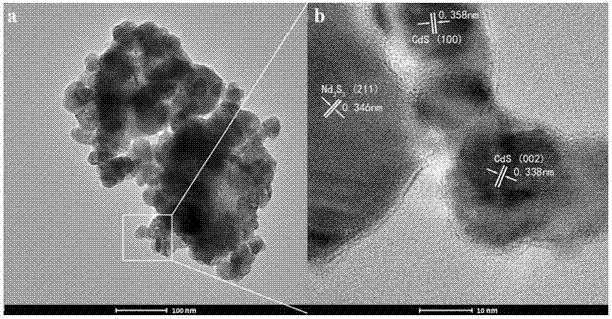Preparation and application of CdS/Nd2S3 nano composite photocatalytic material with visible-light response
A visible light and photocatalytic technology, which is applied in physical/chemical process catalysts, light water/sewage treatment, water/sludge/sewage treatment, etc., can solve the problems of CdS not being stable enough and not having many applications, and achieve the expansion of photoresponse Effects of range, controlled growth and uniformity, controlled generation rate
- Summary
- Abstract
- Description
- Claims
- Application Information
AI Technical Summary
Problems solved by technology
Method used
Image
Examples
Embodiment 1
[0025] (1) Weigh 0.005 mol cadmium nitrate (Cd(NO 3 )·4H 2 O) and 0.01 mmol neodymium nitrate (Nd(NO 3 )·6H 2 O) be dissolved in 100 mL ethylene glycol solution as A solution;
[0026] (2) Add PEG-1000 to the mixed nitrate solution prepared in step (1) as a dispersant, the amount added is 2% of the mass of Cd-Nd-S that can be obtained in reaction theory, stir well until it is completely dissolved ;
[0027](3) Dissolve 0.0051 mol thioacetamide in 100 mL ethylene glycol solution, and use it as solution B after it is completely dissolved;
[0028] (4) Slowly drop solution B into solution A under vigorous stirring, and pass nitrogen gas for 30 minutes after dropping to remove the rest of the gas in the solution;
[0029] (5) Transfer the mixed alcohol solution obtained in step (4) into the reaction kettle, seal it and place it at 120°C for 24 hours of reaction, then take out the reaction kettle, cool it to room temperature, and wash the obtained sample with deionized water a...
Embodiment 2
[0033] (1) Weigh 0.005 mol of cadmium nitrate and 0.02 mmol of neodymium nitrate and dissolve them in 100 mL of glycerol solution as solution A;
[0034] (2) Add PEG-600 to the mixed nitrate solution prepared in step (1) as a dispersant, the amount added is 4% of the mass of Cd-Nd-S that can be obtained in reaction theory, stir well until it is completely dissolved ;
[0035] (3) Dissolve 0.006 mol of thiourea in 100 mL of glycerol solution, and use it as solution B after it is completely dissolved;
[0036] (4) Same as step (4) in implementation example 1;
[0037] (5) Transfer the mixed alcohol solution obtained in step (4) into the reaction kettle, seal it and place it at 140°C. After reacting for 12 hours, take out the reaction kettle and cool it to room temperature. Washing with water several times, drying at 60°C overnight to obtain the sulfide sample precursor;
[0038] (6) Weigh the sample obtained in step (5) and heat it up to 300 °C at a heating rate of 2 °C / min u...
Embodiment 3
[0041] (1) Weigh 0.006 mol of cadmium nitrate and 0.03 mmol of neodymium nitrate and dissolve them in 100 mL of 1,2-propylene glycol solution as solution A;
[0042] (2) Add PEG-400 to the mixed nitrate solution prepared in step (1) as a dispersant, the amount added is 6% of the mass of Cd-Nd-S that can be obtained in reaction theory, stir well until it is completely dissolved ;
[0043] (3) Dissolve 0.008 mol thiosemicarbazide in 100mL of 1,2-propylene glycol solution, and use it as B solution after it is completely dissolved;
[0044] (4) Same as step (4) in implementation example 1;
[0045] (5) Transfer the mixed alcohol solution obtained in step (4) into the reaction kettle, seal it and place it at 130°C. After reacting for 18 hours, take out the reaction kettle and cool it to room temperature. The obtained sample is centrifuged and then deionized Washed with water several times, dried overnight at 60°C to obtain sulfide samples;
[0046] (6) Weigh the sample obtained ...
PUM
| Property | Measurement | Unit |
|---|---|---|
| particle size | aaaaa | aaaaa |
Abstract
Description
Claims
Application Information
 Login to View More
Login to View More - R&D
- Intellectual Property
- Life Sciences
- Materials
- Tech Scout
- Unparalleled Data Quality
- Higher Quality Content
- 60% Fewer Hallucinations
Browse by: Latest US Patents, China's latest patents, Technical Efficacy Thesaurus, Application Domain, Technology Topic, Popular Technical Reports.
© 2025 PatSnap. All rights reserved.Legal|Privacy policy|Modern Slavery Act Transparency Statement|Sitemap|About US| Contact US: help@patsnap.com



